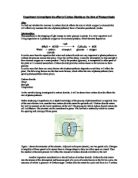The speed of photosynthesis is controlled by all the factors. The speed at which the plant can make food is limited by the lowest factor. For example, a plant may be in a warm place with lots of carbon dioxide but if it is dark then it cannot make food. Light here is the limiting factor. People grow plants in greenhouses to keep the plants warm and help them to grow faster. Some people burn charcoal in greenhouses. As well as warming the air it puts in carbon dioxide to help the plants grow.
Hypothesis: I predict that as the volume of hydrogen carbonate increases so does the number of oxygen bubbles.
Equipment:
- Funnel
- Test tube
- Elodea pondweed
- Blu tac
- Beaker containing water
- Spatula
- Hydrogen carbonate powder
Diagram:
Method:
- Fill beaker with beaker
- Put Elodea plant inside water
- Cover plant with inverted funnel and test tube and stick with blu tac as shown above in diagram
- Count the number of bubbles collected in the test tube for each volume of hydrogen carbonate after 5 minutes
-
Repeat experiment by adding Hydrogen Carbonate in volumes of 5, 10, 15 and 20 cm³ in three different beakers
- Repeat experiment 3 times for each volume of hydrogen carbonate.
Safety rules:
- I will wear goggles throughout the experiment
- Do not make contact with hydrogen carbonate and if this happens wash off with plenty of water immediately
- Normal laboratory rules must be followed at all times
Variables: The variables in this experiment are volume of water, the plant and the hydrogen carbonate powder.
Fair Test: I will keep the volume of water and the plants same throughout the experiment. I will change the volume of hydrogen carbonate. The experiment will be repeated 3 times in different beakers for fair and reliable results. I will justify my hypothesis by looking at similar previous experiments. It is common knowledge that as the concentration of carbon dioxide increases so does the rate of oxygen bubbles produced will also increase. I will also produce reliable accurate results because they will help me make correct conclusions.
I planned the experiment by seeking tuition from various text books like Longman’s and Lonsdale revision guide.
Results:
Conclusion: From the graph I can see that the more hydrogen carbonate I added, the more oxygen bubbles were produced. This means that more carbon dioxide was released and taken up by the plant in photosynthesis. This shows that the more carbon dioxide available to the plant, the faster the rate of photosynthesis. This lead to higher number of oxygen bubbles produced. When the amount of hydrogen carbonate was increased from 15cm³ to 20cm³ the amount of oxygen bubbles produced started to increase at a slower rate. This indicates that at a stage of photosynthesis no matter how much carbon dioxide is available to the plant the rate of photosynthesis will remain constant. The amount of oxygen bubbles may level out. At this point the limiting factor could be amount of light or temperature.
Evaluation: Generally the results obtained during the experiment were accurate. There was one exception which was anomalous and did not fit into the general trend. The results were also reliable because for each volume of hydrogen carbonate added, three different results were obtained and the average found. This was meant to reduce the level of errors. When the amount of hydrogen carbonate added was 10cm³, the amount of oxygen bubbles produced were 13.3. This is an anomalous result because it did not fit into the curve of best fit. This anomalous result could be due to inaccurate readings and measurements. If I was asked to carry out this experiment again, I would rinse my equipment thoroughly before re-using them and have my readings confirmed by someone else before recording them. I think that I have enough evidence to firmly support my evidence because I took several readings and then the graph I obtained is similar to those found in several science text books. To provide further evidence to support my conclusion I could set up a control test with no hydrogen carbonate added. The results obtained will be compared with the results obtained for the experiment in which hydrogen carbonate is added. I could also redo the whole experiment to see and compare the results I obtained if they are similar.









